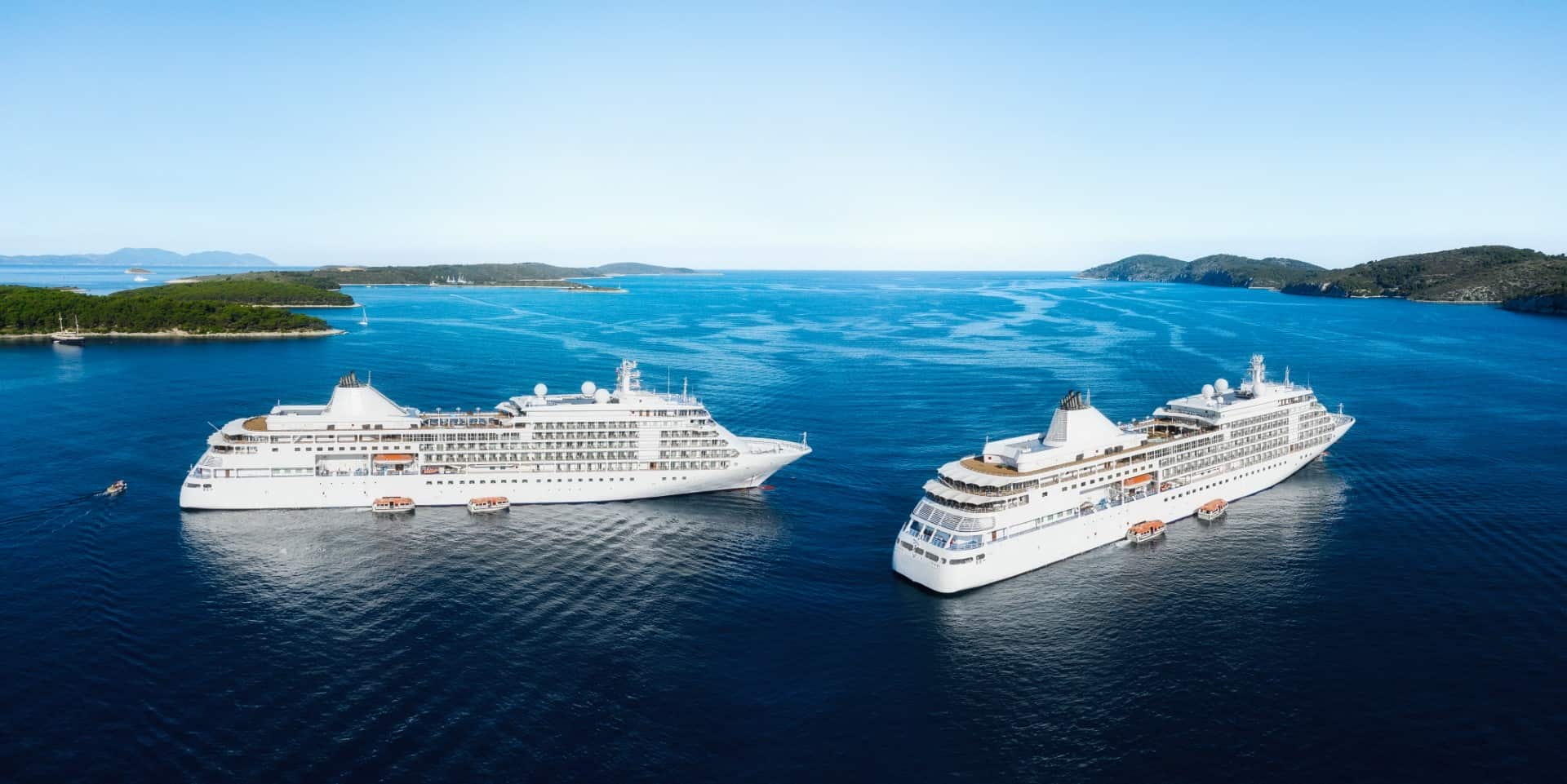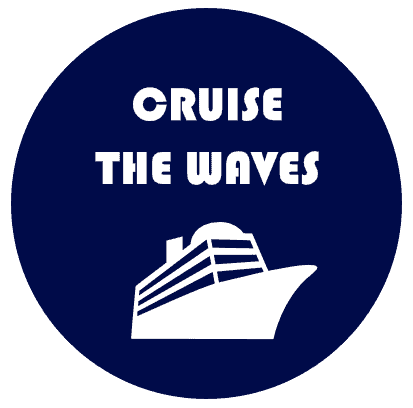One of the most common questions in the cruise industry is how a cruise ship floats in water. Read the article below to find out why and what factors affect how a cruise ship floats.

Why do cruise ships float?
The answer to this question has been debated for years. The most common theory states that they are buoyant because of their large size. But why would you want your ship to be big if it floats on water? Why not just make them smaller so they can fit more people inside? Well, there’s no need to worry about that anymore! Royal Caribbean Cruise Lines have come up with an ingenious solution to this problem – floating dry docks!
How Cruise Ships Stay Afloat?
The first thing you need to know about floating on water is that there are two types: Buoyant or Displacement. “A ship displaces its own weight in water by creating an area of low pressure at the front end of the vessel which pushes out against the surrounding water. This creates more surface area for the hull to push up against, thus increasing the amount of force pushing down into the water below.”
A buoyant ship does exactly what a name suggests; it floats due to air trapped within the structure of the ship itself. These ships use ballast tanks filled with seawater and/or sand to keep themselves afloat. When these ballast tanks fill up with water, the ship sinks until the tank empties again. If you’ve ever seen a boat bobbing around in the ocean, chances are it was a buoyant ship.
So now that we know how cruise ships float, let’s get back to our original question. There are several reasons why cruise ships float. First off, they are very large compared to regular boats. Because of this, they require a lot less energy than traditional boats to remain upright. Another reason is that they are built specifically to withstand rough weather conditions. Finally, they are designed to sit above the waves rather than ride along side of them. All three factors contribute to their ability to float.
The first thing you need to know about floating on water is that if something isn’t heavy enough to stay in place when submerged under water, then it will float away. This means that anything made out of wood or metal sinks like a rock; however, most modern cruise ships are built with steel frames covered by an outer skin of aluminum alloy which makes them more resistant to sinking than their wooden counterparts.
The second factor contributing to the stability of a cruise ship is its shape. Most cruise ships have sharp angles where the hull meets the deck so that there is no flat surface for things to rest against. Also, because the decks are angled downward towards the center of the vessel, any weight placed on top of the ship has nowhere else to go but down. Lastly, since the entire structure sits higher than the surrounding waters, the pressure exerted by the water pushes upwards rather than downwards. Together all of these elements help make cruising safer than other types of transportation.
Floating Dry Docks
Now we’re getting closer to understanding how cruise ships stay afloat. In order to understand this concept better, let’s take a look at some examples of different kinds of boats.
Example 1 – Airplane
An airplane doesn’t really “float” as much as it flies through the air. It uses wings to create lift which allows it to fly without sinking. However, when landing, the plane needs to sink back into the ground to stop from crashing.
Example 2 – Boat
Boats don’t actually float either. They rely on displacement instead. Like airplanes, boats also use sails to move forward. Unlike planes though, boats usually only sail forwards. So even though they aren’t technically floating, they still depend on the same principle behind being able to float.
Floating Dry Dock
Now that we’ve covered both forms of boats, let’s talk about floating drydock. A floating dry dock is basically a giant version of a boat. Instead of using sails like normal boats, however, they use huge propellers called thrusters. Propeller thrusters work similarly to jet engines. As long as the engine runs smoothly, the blades spin quickly enough to generate thrust. Thrusters allow vessels to travel across land while remaining stationary.
What is buoyancy?
Buoyancy is the force that keeps a body floating. It’s also called Archimedes’ Principle, named after Greek mathematician and physicist Archimedes of Syracuse. He was one of the first people to discover this principle. In his book On Floating Bodies he wrote: “If you place an object on water it will float because its weight is less than the amount of fluid displaced by its volume.” This means if there’s more air inside your lungs than outside, you’ll be able to breathe easier. If you’re swimming underwater, you can’t see what’s happening at the bottom of the ocean, but you still feel buoyant because the water around you weighs more than the air inside your lungs. Buoyancy helps keep us afloat even though we don’t weigh much.
Why do some objects sink?
When an object floats, it doesn’t always mean that it stays completely stable. Sometimes, objects fall over due to gravity pulling them into the earth. For example, if you drop a ball from the roof of a building, it falls straight down until it hits the ground. However, if you throw the same ball up high, it won’t hit the ceiling unless someone catches it before it does. Why is this? Gravity pulls everything toward Earth. When an object gets too close to the planet, it starts falling faster and faster. Eventually, it reaches escape velocity and becomes free-falling. Once it leaves Earth’s gravitational pull, it continues moving forward without slowing down. Objects that aren’t held together by friction start breaking apart once they reach escape velocity. They become smaller pieces of matter known as meteoroids. These small particles eventually burn up in the atmosphere. Some of these meteors enter the earth’s atmosphere and collide with each other. Others break apart further and continue traveling through space.
How do buoyancy and density apply to ships?
The ship displaces water when moving forward. As long as there are no leaks, the displacement of water equals the ship’s weight. When the ship moves backward, the water flows back into its original position. In other words, the flow of water around the hull creates pressure pushing upward on the bottom of the boat. This causes the bow to rise up until the net forces acting on the vessel cancel each other out. At this point, the ship is said to be neutrally buoyant.
The ship has reached neutral buoyancy.
Now let’s say that the ship sinks slightly below neutral buoyancy. Water now fills the void left behind by the sinking ship. Since the ship is heavier than the surrounding water, the downward force caused by the water pressing against the underside of the ship increases. This makes the ship move backwards again. But since the ship is lighter than the water, the upward force created by the water flowing past the top of the ship decreases. So the ship begins to move forwards again. Now imagine that the ship sinks so far that the ship is actually submerged under the surface of the water. There isn’t enough room for any additional water to fill the gap between the ship and the sea floor. Therefore, the ship remains stationary while the water level rises above the deck. This situation is known as positive buoyancy. A ship with positive buoyancy tends to stay upright.
In order to maintain stability during movement, a ship must have negative buoyancy or neutral buoyancy. Neutral buoyancy occurs when the ship is neither fully immersed nor fully exposed to the open seas. Ships with negative buoyancy tend to roll side-to-side instead of rolling fore-and-aft like boats with positive buoyancy.
Negative buoyancy happens when the ship is partially submerged beneath the waves. The ship may not be entirely covered by water, but the area underneath the ship is filled with water.
Using the right materials and designs
The design of the hull itself plays an important role in determining the stability of the ship. The shape of the hull determines what kind of forces are created by waves hitting the sides of the ship. If there is too much resistance at any point along the length of the hull then the wave energy cannot pass through and so creates more pressure against the side of the boat. This results in increased stress on the structure and ultimately leads to structural failure.
If you want your boat to remain stable regardless of how deep it goes underwater, make sure that the hull is designed properly. You can use different types of material depending on whether you’re going to sail across shallow waters or deeper ones. For example, if you plan to travel over relatively calm bodies of water such as lakes or rivers, you should choose a light wooden hull because they will float better and resist damage from rough weather conditions. However, if you intend to cross oceans where storms often occur, you’ll need something stronger. Steel is usually used for these kinds of vessels because it doesn’t corrode easily and won’t break apart even after being hit by large objects.
Does density of water affect the way a ship floats?
The answer is yes. The reason for this is that when you have more weight on top, it will push down harder than if there was less weight on top. This means that the center of mass moves to the bottom and thus the boat sinks.
A simple example would be two blocks stacked one atop another with an empty space in between them. If we put some weights into the middle then they’ll sink because their combined force pushes down hard enough to move the center of gravity below the surface of the water.
If you want to know how much difference there is, just measure the distance from the center of mass to the surface of the water before adding any extra weight and after. As far as why ships float at all, I’m not sure but I think it’s related to buoyancy. Buoyant objects tend to rise up out of the water while nonbuoyant ones fall back down. So by having lots of air inside your hull, you’re making yourself heavier so you don’t sink. It doesn’t matter whether or not the air is actually moving around though – it only matters that the volume of air inside the hull is greater than the volume outside.
Do cruise ships ever sink?
Cruise ship disasters are rare, but they do happen. In fact, there have been more than 100 reported incidents of passenger and crew deaths in the past century alone.
Can a cruise ship float upside down?
A floating vessel is not stable. It will tend to roll over and capsize if it loses its balance, or the wind changes direction suddenly. If you are on board when this happens, your best bet is to get out of the way as quickly as possible. The safest place to be in an emergency situation like that would be inside one of the lifeboats. You should also make sure all passengers know how to use them properly.
